History
The village of Barrea descends from the pre-Roman population of the Samnites, who linked their destinies to the village. Currently, along the shores of the lake or in the nearby archaeological site of Alfedena, traces abound from this period. There is a document from the year 996 in which the ancient name of Barrea, Vallis Regia, first appears. This document also mentions that Barrea was given to the Duke of Spoleto during the dark feudal times in Italy, a period noted for its anarchic regimes and barbaric raids.
The Samnites were an ancient Italic people who lived in Samnium in south-central Italy. They became involved in several wars with the Roman Republic until the 1st century BC.

Alfedena is a comune in the province of L'Aquila of the Abruzzo region of central Italy. It is located in the Abruzzo, Lazio and Molise National Park in the upper Sangro valley, near the Monti della Meta mountain chain.
The Duke of Spoleto was the ruler of Spoleto and most of central Italy outside the Papal States during the Early and High Middle Ages. The first dukes were appointed by the Lombard king, but they were independent in practice. The Carolingian conquerors of the Lombards continued to appoint dukes as did their successor to the Holy Roman Empire. In the 12th century, the dukes of Spoleto were far and away the most important imperial vassals in Italy.
Perhaps mainly to protect themselves from the fierce raid of the Huns, the inhabitants of the valley floor sheltered near a Benedictine monastery in a strategic position on the precipice of the river Sangro. Even today the monastery still exists and has withstood the ravages of man and the assault of time and the elements. In the following centuries, the inhabitants of Barrea built a tangle of practically impregnable houses along the southwestern side of the valley. Everything is protected by nature on one side and by observation towers, one round and one square, and defensive walls on the other. Historic records of this town mirror other examples found in Italy: bloody wars, rivalries and even devastating earthquakes.

The Huns were a nomadic people who lived in Central Asia, the Caucasus, and Eastern Europe, between the 4th and 6th century AD. According to European tradition, they were first reported living east of the Volga River, in an area that was part of Scythia at the time; the Huns' arrival is associated with the migration westward of an Indo-Iranian people, the Alans. By 370 AD, the Huns had arrived on the Volga, and by 430 the Huns had established a vast, if short-lived, dominion in Europe, conquering the Goths and many other Germanic peoples living outside of Roman borders, and causing many others to flee into Roman territory. The Huns, especially under their King Attila made frequent and devastating raids into the Eastern Roman Empire. In 451, the Huns invaded the Western Roman province of Gaul, where they fought a combined army of Romans and Visigoths at the Battle of the Catalaunian Fields, and in 452 they invaded Italy. After Attila's death in 453, the Huns ceased to be a major threat to Rome and lost much of their empire following the Battle of Nedao (454?). Descendants of the Huns, or successors with similar names, are recorded by neighbouring populations to the south, east and west as having occupied parts of Eastern Europe and Central Asia from about the 4th to 6th centuries. Variants of the Hun name are recorded in the Caucasus until the early 8th century.
One side of the original, central castle was protected from invaders by natural means, utilizing the impassably steep slope of the mountain; two stone castle gates afforded other protection to the castle and the homes that were built within its walls, dug into the slides of the mountain and giving out through front entrances facing on narrow, twisting, steep stone alleys.
Its location surrounded by the Apennines would have prevented Barrea's development into an industrial area had not other economic obstacles also existed; historically, residents existed by tending small farms in plots on the mountainside. A major emigration took place after the earthquake of 1984, when many residents declined to return to the homes that were ruined in the tremor. Many of the homes have been bought by tourists, who enjoy Barrea's location on the brow of a mountainside, giving out over the Sangro valley, but there are fewer than 1,000 permanent inhabitants.
Today, Barrea is at the center of the National Park of Abruzzo, Lazio and Molise, a natural area rich in wildlife and recreation and lacking any aspect of urban commercialization. The village contains many monuments to its sufferings in World War II, when it was subjected to Allied bombings.
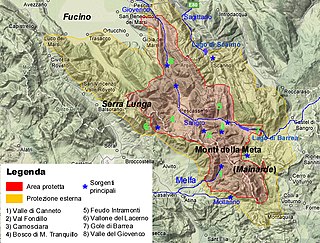
Parco Nazionale d'Abruzzo, Lazio e Molise is an Italian national park founded in 1922. The majority of the park is located in the Abruzzo region though it is not constrained by regional boundaries and also includes territory in Lazio and Molise. The park headquarters are in Pescasseroli in the Province of L'Aquila. The park currently includes 496.80 km2 (191.82 sq mi).

Abruzzo is a region of Southern Italy with an area of 10,763 square km and a population of 1.2 million. It is divided into four provinces: L'Aquila, Teramo, Pescara, and Chieti. Its western border lies 80 km (50 mi) east of Rome. Abruzzo borders the region of Marche to the north, Lazio to the west and south-west, Molise to the south-east, and the Adriatic Sea to the east. Geographically, Abruzzo is divided into a mountainous area in the west, which includes the Gran Sasso d'Italia, and a coastal area in the east with beaches on the Adriatic Sea.
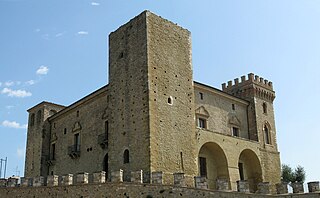
Crecchio is a comune and village in the province of Chieti, part of the Abruzzo region in central Italy. The village preserves its medieval aspect and is dominated by its castle.

The Province of Campobasso is a province in the Molise region of southern Italy. Its capital is the city of Campobasso.

Castel di Sangro is a city and comune of 6,461 people in the Province of L'Aquila, in Abruzzo, Central Italy. It is the main city of the Alto Sangro e Altopiano delle Cinque Miglia area.

Lake Trasimeno, also referred to as Trasimene or Thrasimene in English, is a lake in the province of Perugia, in the Umbria region of Italy. The lake is south of the river Po and north of the nearby river Tiber, has a surface area of 128 km2 (49.4 sq mi) and is the fourth for surface area in Italy. Only two minor streams flow directly into the Lake and none flows out. The water level of the lake fluctuates significantly according to rainfall levels and the seasonal demands from the towns, villages and farms near the shore.
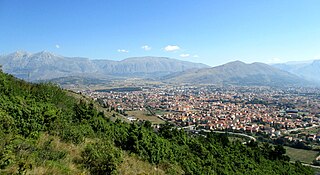
Avezzano is a city and comune with a population of about 42,500 inhabitants, situated in the Abruzzo region, province of L'Aquila, Italy. It is the second most populous municipality in the province and the sixth in the region. Avezzano was documented as an existing urban center in the ninth century. The city was destroyed by the earthquake of 1915. It was rebuilt after the 1944 Allied bombing. The city was decorated with the silver medal for civil merit, an award granted by the Italian Republic.

Val Camonica is one of the largest valleys of the central Alps, in eastern Lombardy, Italy. It extends about 90 kilometres (56 mi) from the Tonale Pass to Corna Trentapassi, in the commune of Pisogne near Lake Iseo. It has an area of about 1,335 km2 (515 sq mi) and 118,323 inhabitants.

Pescasseroli is a town and comune in the province of L'Aquila, in Southern Abruzzo, central Italy.

Celano is a town and comune in the Province of L'Aquila, central Italy, 120 km (75 mi) east of Rome by rail.

Scanno is a town and comune in the province of L'Aquila, in the Abruzzo region of central Italy.

Archi is a town and comune in the province of Chieti, Abruzzo, southern Italy. It is part of the Valsangro mountain community.

Bugnara is a comune and village in the province of L'Aquila in the Abruzzo region of central Italy. In 2007, it was designated as one of the most beautiful villages in Italy, an association that notes small Italian towns of strong artistic and historical interest.
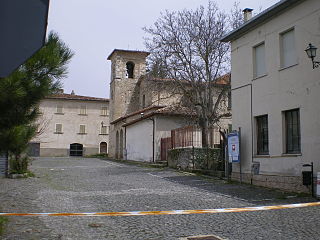
Ocre is a comune (municipality) and town in the province of L'Aquila in the Abruzzo region of southern Italy. Its c. 1000 inhabitants live in several small villages scattered across the mid-to–low L’Aquila basin, about 15 kilometers south east of Abruzzo’s regional capital. The town hall offices are located in San Panfilo d’Ocre. It belongs to the Amiternina mountain community and part of the territory lies in the Sirente Velino Regional Park.

Roccacasale is a comune in the Province of L'Aquila in the Abruzzo region of Italy. Built on the slopes of the Monte della Rocca in the central Apennines, the village overlooks the Peligna Valley and the town of Sulmona.

Civitella Casanova is an Italian town of inland mountain of 1,950 inhabitants in the province of Pescara in Abruzzo and belongs to the mountain community Vestina. Listed on the National Park of Gran Sasso and Monti della Laga and the Regional Reserve Voltigno and Valle d'Angri, a regional reserve included in the National Park, the country bases its economy mainly on agriculture.
It has pre-Roman origins of repute, the sources of the historian Livy emerges as the town of Civitella was called Cutina or Cingilia.

A rocca is a type of Italian fortified stronghold, or fortress, typically located on a hilltop, beneath or on which a village or town historically clustered so that the inhabitants might take refuge at times of trouble. Generally under its owners' patronage the settlement might hope to find prosperity in better times. A rocca might in reality be no grander than a fortified farmhouse. A more extensive rocca would be referred to as a castello.
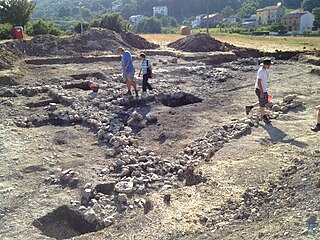
The Sangro Valley Project is an Anglo-American ongoing archaeological excavation in Abruzzo, Italy. It is notable for its revolutionary interpretation of Samnium as a dynamic participant in the history of the Adriatic as well as its early adoption of modern excavation technologies, such as GIS. The project currently managed by Oberlin College in collaboration with Oxford University, Durham University and the Soprintendenza per i Beni Archeologici dell'Abruzzo, is a multi-disciplinary team of specialists from Canada, Italy, the United Kingdom, and the United States.





























